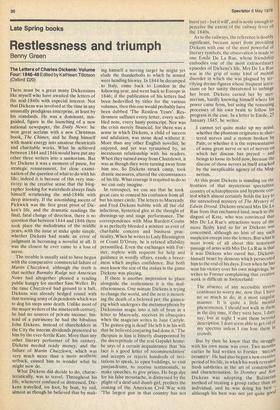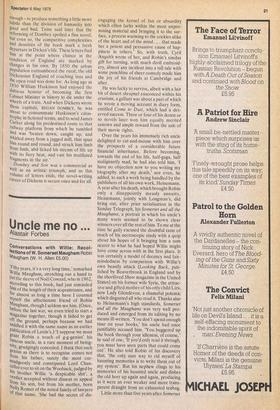Late Spring books
Restlessness and triumph
Benny Green
The Letters of Charles Dickens: Volume Four: 1846-48 Edited by Kathleen Tillotson (Oxford E20)
There must be a great many Dickensians like myself who have awaited the letters of the mid-1840s with especial interest. Not that Dickens was involved at the time in any unusually prodigious enterprise, at least by his standards. He was a dominant, misguided, figure in the launching of a new national newspaper, the Daily News: he won great acclaim with a new Christmas book, The Chimes, and he flung himself with manic energy into amateur theatricals and charitable works. What he achieved between 1844 and 1846 would have put any other three writers into a sanitorium. But for Dickens it was a moment of pause, for strategic reassessment, for close examination of the question of what to do with his life; indeed it is because of this very inactivityl in the creative sense that the biographer looking for watersheds always finds himself scrutinising the mid-1840s with deep intensity. If the astonishing ascent of Pickwick was the first great pivot of Dicken's life, and the dramatic readings the final, fatal change of direction, there is no question that between 1844 and 1846 there took place the melodrama of the middle years,. with the issue at stake quite simple, whether Dickens had made an error of judgment in becoming a novelist at all It was the closest he ever came to a loss of nerve.
The trouble is usually said to have begun with the comparative commercial failure of Martin Chuzzlewit, although the truth is that neither Barnaby Budge nor American Notes had altogether pleased a reading public hungry for another Sam Weller. By the time Chuzzlewit had ground to a halt, Dickens was already hedged round with that teeming army of dependents which was to dog his steps unto death. Unlike most of the major writers of the nineteenth century, he had no sources of private income. Instead of a patrimony he had the bibulous John Dickens, instead of shareholders in the City the interim dividends presented to him by the ever-fertile Kate. More than any other literary performer of his century, Dickens needed ready money, and the failure of Martin Chuzzlewit, which was very much more than a mere aesthetic setback, caused him to wonder what he might now do.
What Dickens did decide to do, characteristically, was to travel. Throughout his life, whenever confused or distressed. Dickens travelled, on foot, by boat, by rail, almost as though he believed that by mak ing himself a moving target he might yet elude the thunderbolts to which he sensed were heading his way. In 1844 he decamped to Italy, came back to London in the following year, and went back to Europe in 1846; if the publication of his letters had been bedevilled by titles for the various volumes, then this one would probably have been dubbed The Restless Years'. Restlessness suffuses every letter, every scribbled note, every hasty postscript. Nor was the crisis merely financial, for there was a sense in which Dickens, a child of success and adulation, was stone dead without it. More than any other English novelist, he enjoyed, and yet was tyran.nised by, an incestuous relationship with his readers. When they turned away from Chuzzlewit, it was as though they were turning away from him too. So Dickens struck camp, took drastic measures, altered the circumstances of his life. What courage it required to do so we can only imagine.
In retrospect, we can see that he took great care to conceal his confusion from all but his inner circle. The letters to Macready and Fred Dickens bubble With all the old infectious, hysterical glee at the thought of dressings-up and stage performance. The correspondence with Miss Burdett-Coutts is as perfectly blended a mixture as ever of charitable concern and business practicality. When he writes to Lady Blessington or Count D'Orsay, he is relaxed affability personified. Even the exchanges wjth Forster, replete with requests for help and guidance in wordly affairs, exude a breeziness which implies confidence. But both men knew the size of the stakes in the game Dickens was playing.
If there is another impression to place alongside the restlessness it is the multifariousness. One minute Dickens is trying to change the world, and the next is mourning the death of a beloved pet: the guineapig which undergoes the metamorphosis by Dickensian magic into a tub of bran in a letter to Macready, receives its obsequies when the magician writes to Jane Carlyle, 'The guinea-pig is dead! He left it in his will that he believed conjuring had done it.' The thespian in him is bitterly disappointed by the decreptitude of the real Gapulet home: he says of a certain acquaintance that 'his face is a good letter of recommendation' and accepts or rejects hundreds of invitations to speak, to open buildings, to visit panjandrums, to receive testimonials, to make speeches, to give prizes. He begs dye for his false moustache, is distressed by the plight of a deaf-and-dumb girl, predicts the 'coming of the American Civil War with 'The largest gun in that country has not
burst yet -but it will', and is acute enough to perceive the extent of the railway fever of the 1840s.
As to the railways, the reference is doubly significant, because apart from providing Dickens with one of the most powerful of literary symbols, the observation is made to one Emile De La Rue, whose friendship embodies one of the most extraordinary episodes of Dickens's life. Mrs De La Rue was in the grip of some kind of mental disorder in which she was plagued by terrifying dream-figures whose frequent intrusions on her sanity threatened to unhinge her brain. Dickens cursed her by mesmerism, hardly knowing himself where his power came from, but using the reasoning processes of his own brain to follow his progress in the case. In a letter to Emile, Z5 January 1845, he writes: I cannot yet quite make up my mind, whether the phantom originates in shattered nerves and a system broken by Pain; or whether it is the representative of some great nerve or set of nerves on which her disease has preyed and beings to loose its hold now, because the disease of those nerves as itself attacked by the inexplicable agency of the Magnetism.
' At this point Dickens is standing on the frontiers of that mysterious spectultive country of schizophrenia and hypnotic control which almost certainly holds the key to the unresolved mystery of The Mystery of Edwin Drood. Dickens rescued Mrs De La Rue from that enchanted land, much to the disgust of Kate, who was convinced that Mrs De La Rue's attractions were of the more fleshy kind so far as Dickens was concerned, although no hint of any such suspicion creeps into the letters. But what Is most ironic of all about this notorious passage of arms with Mrs De La Rue is that it was Dickens who cured her, Dickens, himself beset by demons which persecuted him to the end of his days. Even when he has won his victory over his own misgivings, he writes to Forster complaining that creative work is difficult in Switzerland:
The absence of any accessible streets continues to worry me, now that I have no so much to do, in a most singular manner. It is quite a little mental phenomenon. I should not walk in them in the day time, if they were here, I dare say; but at night I want them beyond description. I dont seem able to get rid of my spectres unless I can lose them In crowds.
But by then he knew that the struggle with his own muse was over. Two months earlier he had written to Forster 'BEGAN DOMBEY' . He had also begun a new creative period of his life, in which his woric revealed fresh subtleties in the art of construction and characterisation. In Dombey and Son Dickens was adopting the Balzacian method of treating a group rather than an individual, and he was doing his best -although his best was not yet quite gor'd enough—to produce something a little more sttbtle than the division of humanity into good and bad. Taine said later that the reforming of Dombey spoiled a fine novel, but even so, the comparitive complexities and densities of the book mark a fresh departure in Dicken's life. These letters find him at the point where chance in the condition of England are marked by Changes in his own. By 1850 the urban Population outnumbered the rural; the old Dickensian England of coaching inns and the open road was done for. As long ago as 1830 William Huskisson had enjoyed the dubious honour of becoming the first Cabinet Minister in history to die under the Wheels of a train. And when Dickens wrote those capitals, BEGAN DOMBEY, he was about to consummate Huskisson's catastrophe in fictional terms, and to send James Carker along his predestined route to that railway platform from which he tumbled and was 'beaten down, caught up, and Whirled away from a jagged mill, that spun him round and round, and struck him limb from limb, abd licked his stream of life up With its fiery heat, and cast his mutilated fragments in the air.'
Dombey and Son was a commercial as Well as an artistic triumph, and as this
volume of letters ends, the novel-writing Career of Dickens is secure once and for all.







































 Previous page
Previous page